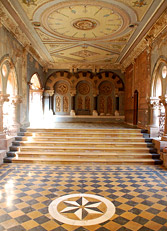The picturesque town of Bhuj has spectacular scenery. Bhuj the former capital of native state of Kutch is now the headquarters of the district. Located rather low, it is basically an amphitheatre of hills dominated by the Bhuja Hill that rises to a height of 160 m at one end and is a landmark being flat on top, surmounted by the fortifications of a hill fort. This strategically located fort obviously served the purpose of sighting enemies and alerting defense. An old wall surrounds the city built for precautions.The city wall, thirty five feet high and 4 feet thick with towers positioned asymmetrically was formerly armed with 51 guns. Bhuj is blessed with some incredible historic heritages.
History of Bhuj
In 1510, Maharao Hamir founded Bhuj. In 1549 Rao Khengarji I made Bhuj his capital. It remained an independent princely state during the rule of the British in India and became a part of India, when it gained independence in 1947.
Geography of Bhuj
Bhuj lies at the heart of Kutch and is linked by many roads to the rest of the peninsula. Bhuj is a city and a municipality in Kachchh district in the state of Gujarat. At present, Bhuj is the district headquarter of the Kachchh ditrict which is the second largest district of India. Bhuj is located at 23.27° N 69.67° E. It has an average elevation of 110 meters. On the eastern side of the town is a hill, Bhujiyo that separates Bhuj and Madhapar village. One of the biggest lakes at Bhuj is Hamirsar.
Transportation of Bhuj
Bhuj is well connected to other major cities by means of air, rail and road. There is a domestic airport at Bhuj from where daily flights operate to Mumbai.
Demographics of Bhuj
As per the 2000 census, the population of Bhuj was 136429 out of which 71056 were males and 65373 were females.
Education of Bhuj
One of the famous universities of Bhuj is the Krantiguru Shyamji Krishna Verma Kachchh University. This university has 22 affiliated colleges; seven of them are in Bhuj. University bestows degrees in Arts, Science, Commerce, Law, Education, Management, Pharmacy, Social Welfare and Engineering.
Places of attraction at Bhuj
 The places of attraction at Bhuj are:
The places of attraction at Bhuj are:
• Aina Mahal or the Palace of Mirrors (Old Palace)
•Prag Mahal (New Palace)
• The Kuchch Museum
•The Sarad Bagh Palace
•The Swaminarayan Temple
• Bharatiya Sanskriti Darshan Kachch (folk museum)
• Anjal Wild Ass Sanctuary
•The town of Gandhidham.
Fairs and Festivals of Bhuj
The major festival of Bhuj is the Rann Utsav (festival) or the desert festival. This festival usually coincides with the Hindu festival of Shivratri. The main attractions of this festival are display of traditional handicrafts, cultural events and tours in and around the city.



















